Advanced Practice Nursing Case Study: Lung Function Decline Analysis
VerifiedAdded on 2022/10/02
|13
|3362
|174
Case Study
AI Summary
This assignment presents a case study of a 56-year-old man experiencing an accelerated decline in lung function. The student addresses the patient's subjective and objective data, appropriate national guidelines, and necessary tests. It explores the need for consultation, medical and nursing diagnoses, and ethical considerations. The assignment outlines a comprehensive plan of care, including medical interventions like bronchodilators and steroid inhalers, alongside a detailed nursing care plan emphasizing patient positioning, breathing techniques, and complementary treatments such as mind-body practices. The study underscores the importance of patient education, lifestyle modifications, and addressing the ethical dilemmas related to decision-making in progressive lung function deterioration. The assignment covers all aspects of patient care from assessment to treatment and ethical considerations.
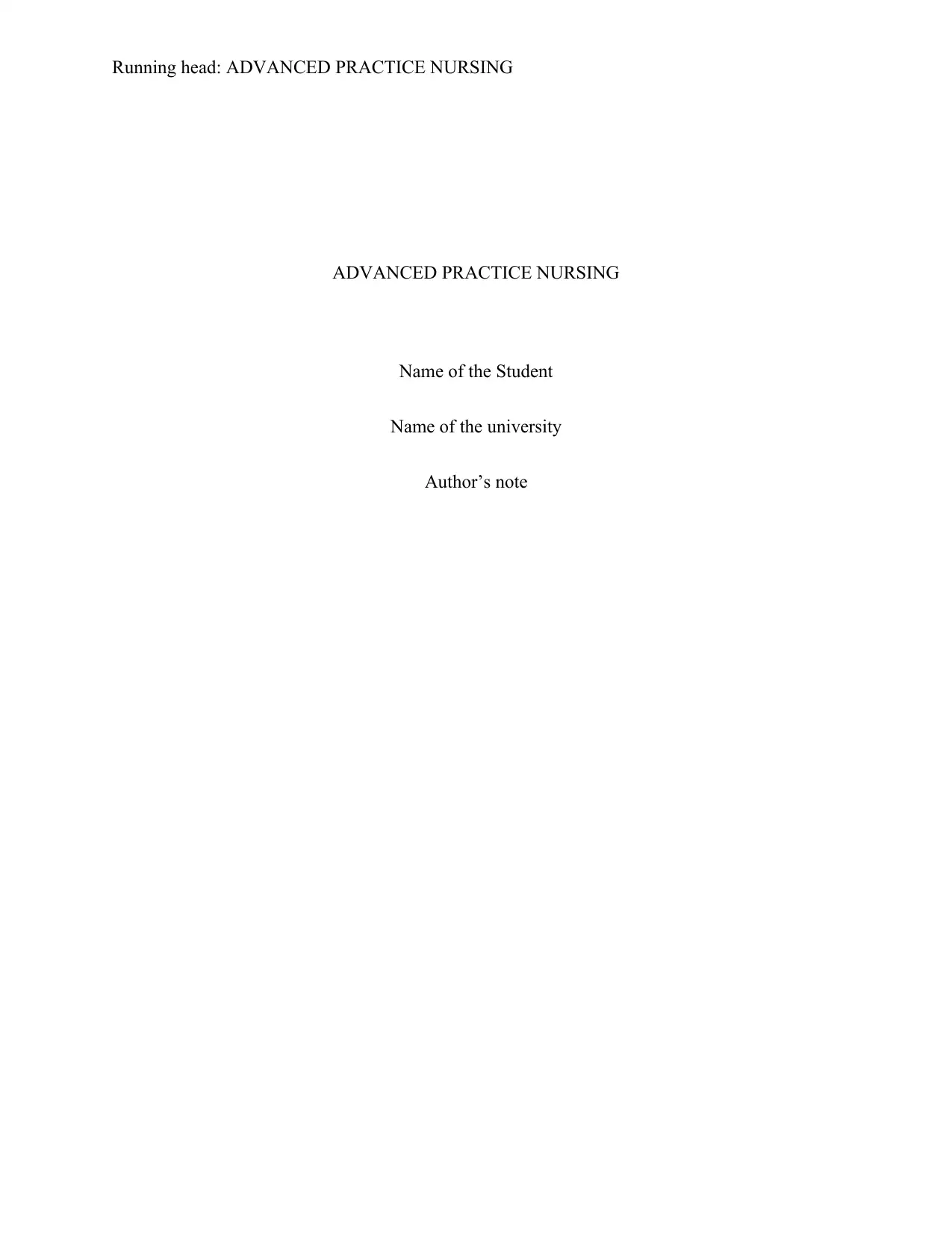
Running head: ADVANCED PRACTICE NURSING
ADVANCED PRACTICE NURSING
Name of the Student
Name of the university
Author’s note
ADVANCED PRACTICE NURSING
Name of the Student
Name of the university
Author’s note
Paraphrase This Document
Need a fresh take? Get an instant paraphrase of this document with our AI Paraphraser
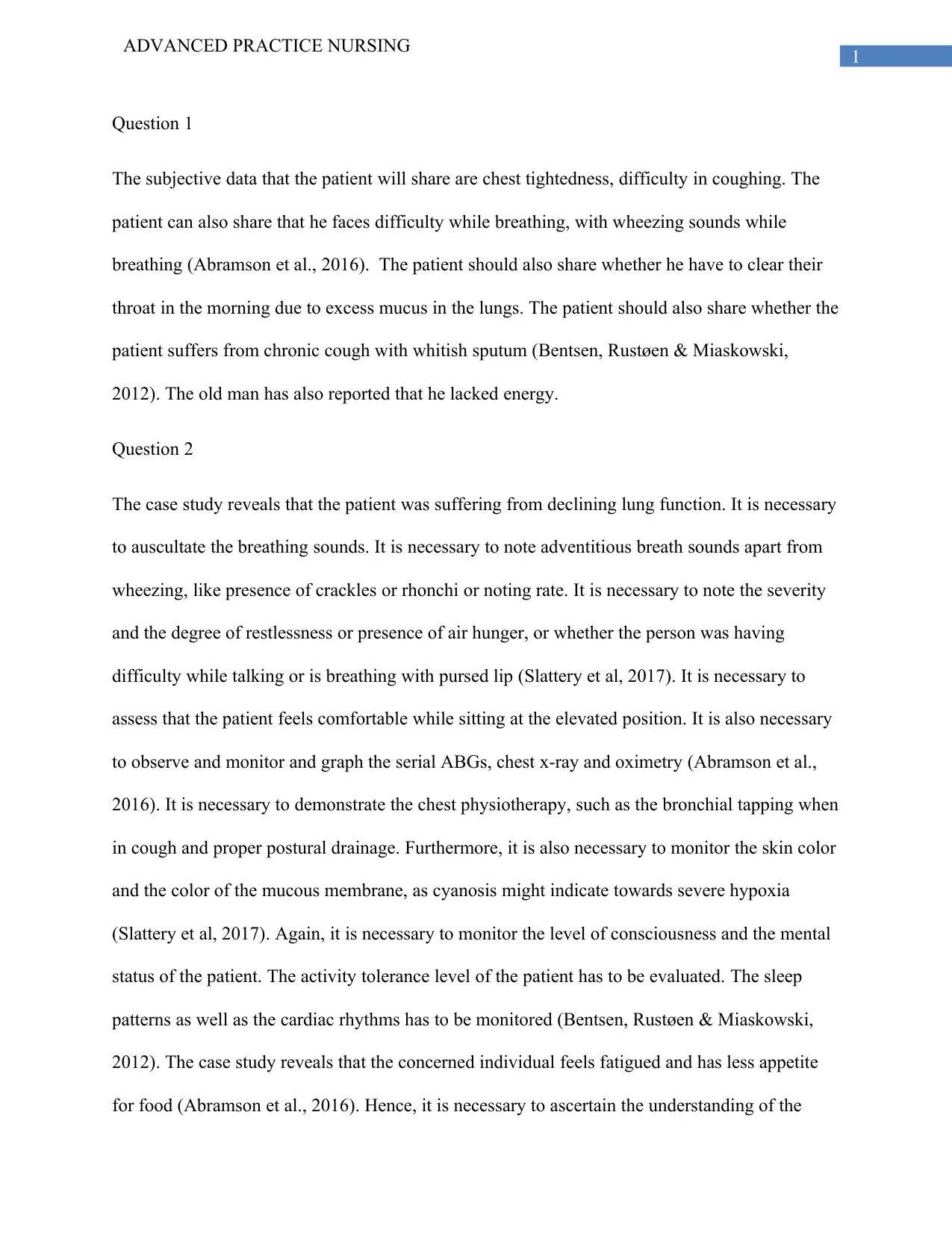
1
ADVANCED PRACTICE NURSING
Question 1
The subjective data that the patient will share are chest tightedness, difficulty in coughing. The
patient can also share that he faces difficulty while breathing, with wheezing sounds while
breathing (Abramson et al., 2016). The patient should also share whether he have to clear their
throat in the morning due to excess mucus in the lungs. The patient should also share whether the
patient suffers from chronic cough with whitish sputum (Bentsen, Rustøen & Miaskowski,
2012). The old man has also reported that he lacked energy.
Question 2
The case study reveals that the patient was suffering from declining lung function. It is necessary
to auscultate the breathing sounds. It is necessary to note adventitious breath sounds apart from
wheezing, like presence of crackles or rhonchi or noting rate. It is necessary to note the severity
and the degree of restlessness or presence of air hunger, or whether the person was having
difficulty while talking or is breathing with pursed lip (Slattery et al, 2017). It is necessary to
assess that the patient feels comfortable while sitting at the elevated position. It is also necessary
to observe and monitor and graph the serial ABGs, chest x-ray and oximetry (Abramson et al.,
2016). It is necessary to demonstrate the chest physiotherapy, such as the bronchial tapping when
in cough and proper postural drainage. Furthermore, it is also necessary to monitor the skin color
and the color of the mucous membrane, as cyanosis might indicate towards severe hypoxia
(Slattery et al, 2017). Again, it is necessary to monitor the level of consciousness and the mental
status of the patient. The activity tolerance level of the patient has to be evaluated. The sleep
patterns as well as the cardiac rhythms has to be monitored (Bentsen, Rustøen & Miaskowski,
2012). The case study reveals that the concerned individual feels fatigued and has less appetite
for food (Abramson et al., 2016). Hence, it is necessary to ascertain the understanding of the
ADVANCED PRACTICE NURSING
Question 1
The subjective data that the patient will share are chest tightedness, difficulty in coughing. The
patient can also share that he faces difficulty while breathing, with wheezing sounds while
breathing (Abramson et al., 2016). The patient should also share whether he have to clear their
throat in the morning due to excess mucus in the lungs. The patient should also share whether the
patient suffers from chronic cough with whitish sputum (Bentsen, Rustøen & Miaskowski,
2012). The old man has also reported that he lacked energy.
Question 2
The case study reveals that the patient was suffering from declining lung function. It is necessary
to auscultate the breathing sounds. It is necessary to note adventitious breath sounds apart from
wheezing, like presence of crackles or rhonchi or noting rate. It is necessary to note the severity
and the degree of restlessness or presence of air hunger, or whether the person was having
difficulty while talking or is breathing with pursed lip (Slattery et al, 2017). It is necessary to
assess that the patient feels comfortable while sitting at the elevated position. It is also necessary
to observe and monitor and graph the serial ABGs, chest x-ray and oximetry (Abramson et al.,
2016). It is necessary to demonstrate the chest physiotherapy, such as the bronchial tapping when
in cough and proper postural drainage. Furthermore, it is also necessary to monitor the skin color
and the color of the mucous membrane, as cyanosis might indicate towards severe hypoxia
(Slattery et al, 2017). Again, it is necessary to monitor the level of consciousness and the mental
status of the patient. The activity tolerance level of the patient has to be evaluated. The sleep
patterns as well as the cardiac rhythms has to be monitored (Bentsen, Rustøen & Miaskowski,
2012). The case study reveals that the concerned individual feels fatigued and has less appetite
for food (Abramson et al., 2016). Hence, it is necessary to ascertain the understanding of the
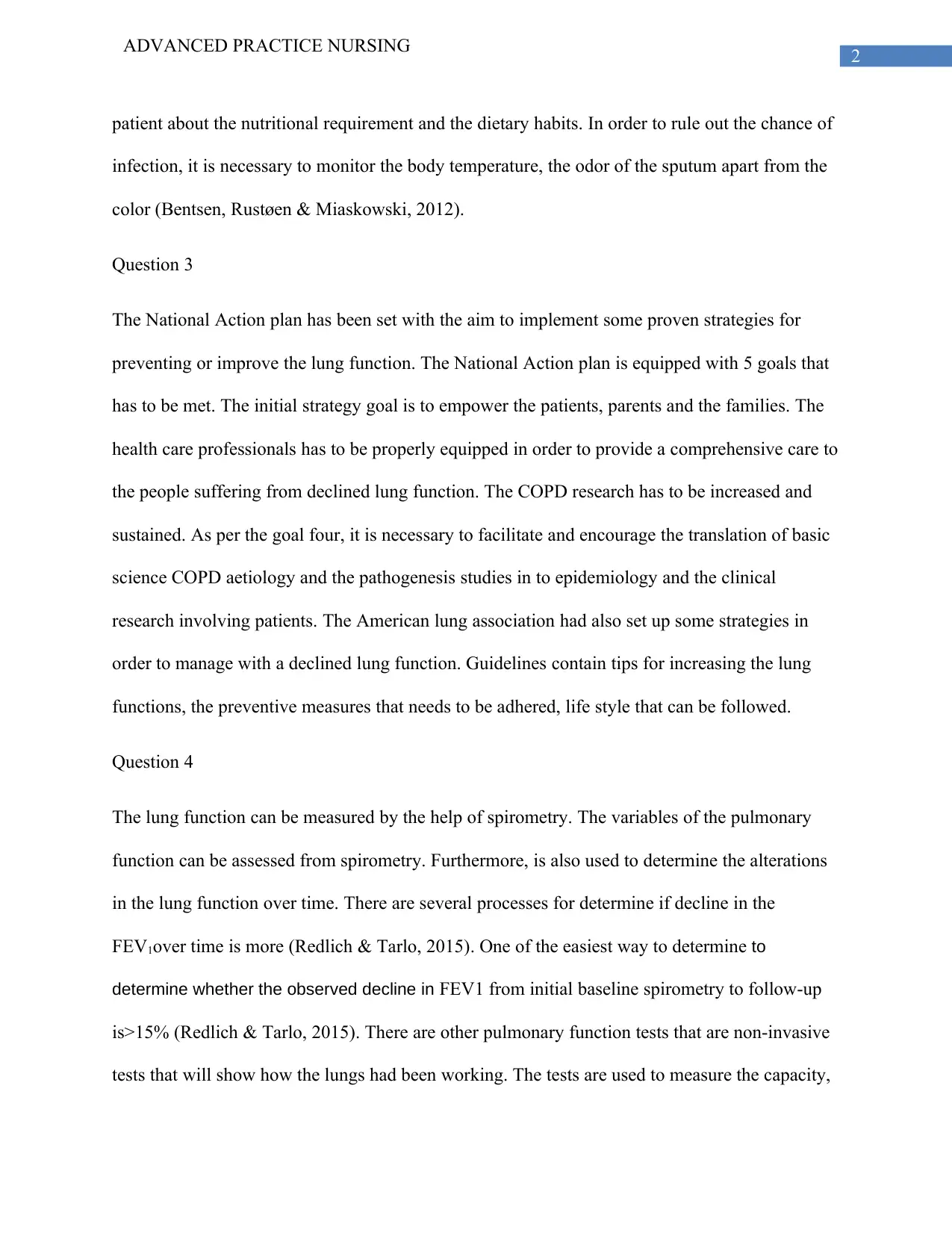
2
ADVANCED PRACTICE NURSING
patient about the nutritional requirement and the dietary habits. In order to rule out the chance of
infection, it is necessary to monitor the body temperature, the odor of the sputum apart from the
color (Bentsen, Rustøen & Miaskowski, 2012).
Question 3
The National Action plan has been set with the aim to implement some proven strategies for
preventing or improve the lung function. The National Action plan is equipped with 5 goals that
has to be met. The initial strategy goal is to empower the patients, parents and the families. The
health care professionals has to be properly equipped in order to provide a comprehensive care to
the people suffering from declined lung function. The COPD research has to be increased and
sustained. As per the goal four, it is necessary to facilitate and encourage the translation of basic
science COPD aetiology and the pathogenesis studies in to epidemiology and the clinical
research involving patients. The American lung association had also set up some strategies in
order to manage with a declined lung function. Guidelines contain tips for increasing the lung
functions, the preventive measures that needs to be adhered, life style that can be followed.
Question 4
The lung function can be measured by the help of spirometry. The variables of the pulmonary
function can be assessed from spirometry. Furthermore, is also used to determine the alterations
in the lung function over time. There are several processes for determine if decline in the
FEV1over time is more (Redlich & Tarlo, 2015). One of the easiest way to determine to
determine whether the observed decline in FEV1 from initial baseline spirometry to follow-up
is>15% (Redlich & Tarlo, 2015). There are other pulmonary function tests that are non-invasive
tests that will show how the lungs had been working. The tests are used to measure the capacity,
ADVANCED PRACTICE NURSING
patient about the nutritional requirement and the dietary habits. In order to rule out the chance of
infection, it is necessary to monitor the body temperature, the odor of the sputum apart from the
color (Bentsen, Rustøen & Miaskowski, 2012).
Question 3
The National Action plan has been set with the aim to implement some proven strategies for
preventing or improve the lung function. The National Action plan is equipped with 5 goals that
has to be met. The initial strategy goal is to empower the patients, parents and the families. The
health care professionals has to be properly equipped in order to provide a comprehensive care to
the people suffering from declined lung function. The COPD research has to be increased and
sustained. As per the goal four, it is necessary to facilitate and encourage the translation of basic
science COPD aetiology and the pathogenesis studies in to epidemiology and the clinical
research involving patients. The American lung association had also set up some strategies in
order to manage with a declined lung function. Guidelines contain tips for increasing the lung
functions, the preventive measures that needs to be adhered, life style that can be followed.
Question 4
The lung function can be measured by the help of spirometry. The variables of the pulmonary
function can be assessed from spirometry. Furthermore, is also used to determine the alterations
in the lung function over time. There are several processes for determine if decline in the
FEV1over time is more (Redlich & Tarlo, 2015). One of the easiest way to determine to
determine whether the observed decline in FEV1 from initial baseline spirometry to follow-up
is>15% (Redlich & Tarlo, 2015). There are other pulmonary function tests that are non-invasive
tests that will show how the lungs had been working. The tests are used to measure the capacity,
⊘ This is a preview!⊘
Do you want full access?
Subscribe today to unlock all pages.

Trusted by 1+ million students worldwide
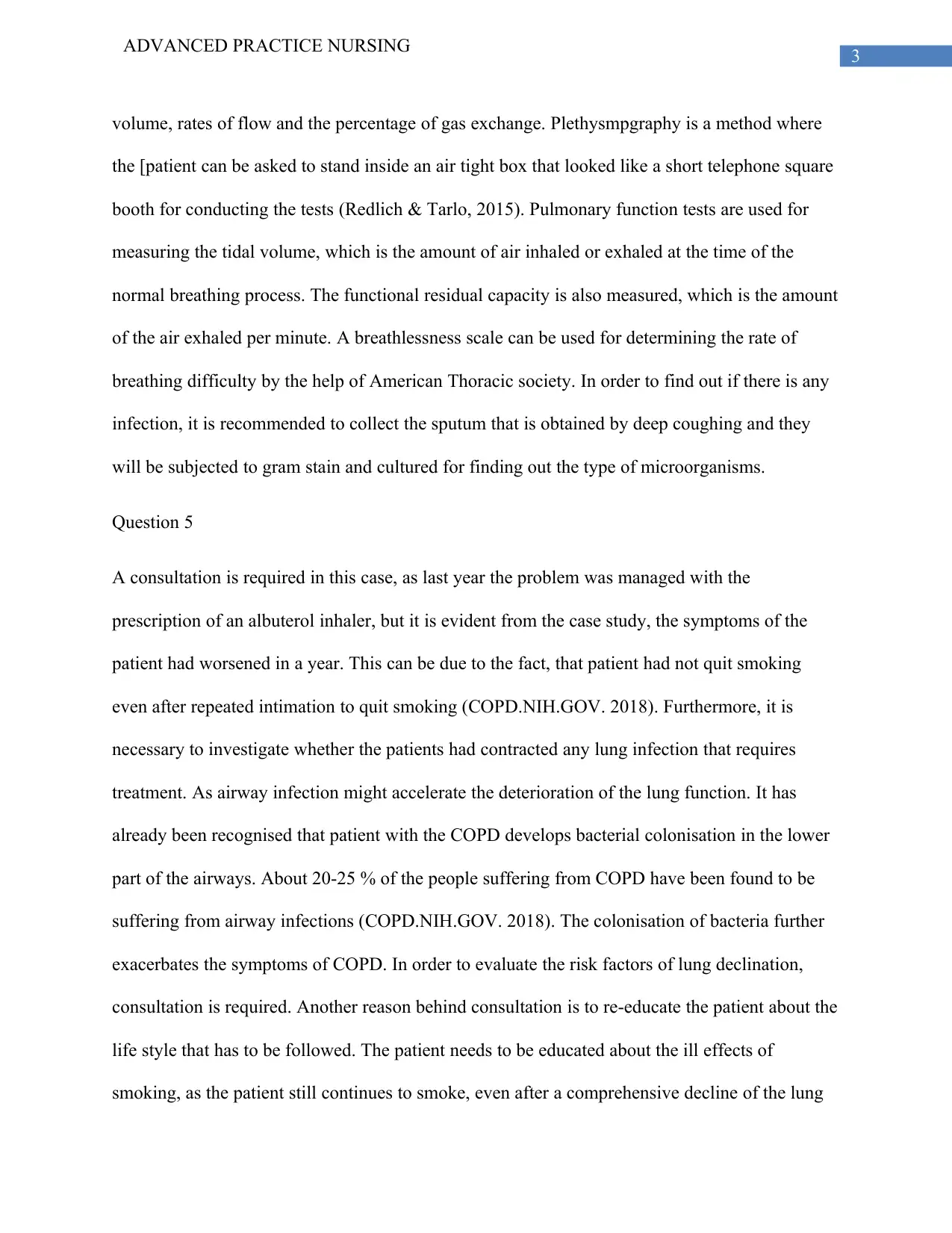
3
ADVANCED PRACTICE NURSING
volume, rates of flow and the percentage of gas exchange. Plethysmpgraphy is a method where
the [patient can be asked to stand inside an air tight box that looked like a short telephone square
booth for conducting the tests (Redlich & Tarlo, 2015). Pulmonary function tests are used for
measuring the tidal volume, which is the amount of air inhaled or exhaled at the time of the
normal breathing process. The functional residual capacity is also measured, which is the amount
of the air exhaled per minute. A breathlessness scale can be used for determining the rate of
breathing difficulty by the help of American Thoracic society. In order to find out if there is any
infection, it is recommended to collect the sputum that is obtained by deep coughing and they
will be subjected to gram stain and cultured for finding out the type of microorganisms.
Question 5
A consultation is required in this case, as last year the problem was managed with the
prescription of an albuterol inhaler, but it is evident from the case study, the symptoms of the
patient had worsened in a year. This can be due to the fact, that patient had not quit smoking
even after repeated intimation to quit smoking (COPD.NIH.GOV. 2018). Furthermore, it is
necessary to investigate whether the patients had contracted any lung infection that requires
treatment. As airway infection might accelerate the deterioration of the lung function. It has
already been recognised that patient with the COPD develops bacterial colonisation in the lower
part of the airways. About 20-25 % of the people suffering from COPD have been found to be
suffering from airway infections (COPD.NIH.GOV. 2018). The colonisation of bacteria further
exacerbates the symptoms of COPD. In order to evaluate the risk factors of lung declination,
consultation is required. Another reason behind consultation is to re-educate the patient about the
life style that has to be followed. The patient needs to be educated about the ill effects of
smoking, as the patient still continues to smoke, even after a comprehensive decline of the lung
ADVANCED PRACTICE NURSING
volume, rates of flow and the percentage of gas exchange. Plethysmpgraphy is a method where
the [patient can be asked to stand inside an air tight box that looked like a short telephone square
booth for conducting the tests (Redlich & Tarlo, 2015). Pulmonary function tests are used for
measuring the tidal volume, which is the amount of air inhaled or exhaled at the time of the
normal breathing process. The functional residual capacity is also measured, which is the amount
of the air exhaled per minute. A breathlessness scale can be used for determining the rate of
breathing difficulty by the help of American Thoracic society. In order to find out if there is any
infection, it is recommended to collect the sputum that is obtained by deep coughing and they
will be subjected to gram stain and cultured for finding out the type of microorganisms.
Question 5
A consultation is required in this case, as last year the problem was managed with the
prescription of an albuterol inhaler, but it is evident from the case study, the symptoms of the
patient had worsened in a year. This can be due to the fact, that patient had not quit smoking
even after repeated intimation to quit smoking (COPD.NIH.GOV. 2018). Furthermore, it is
necessary to investigate whether the patients had contracted any lung infection that requires
treatment. As airway infection might accelerate the deterioration of the lung function. It has
already been recognised that patient with the COPD develops bacterial colonisation in the lower
part of the airways. About 20-25 % of the people suffering from COPD have been found to be
suffering from airway infections (COPD.NIH.GOV. 2018). The colonisation of bacteria further
exacerbates the symptoms of COPD. In order to evaluate the risk factors of lung declination,
consultation is required. Another reason behind consultation is to re-educate the patient about the
life style that has to be followed. The patient needs to be educated about the ill effects of
smoking, as the patient still continues to smoke, even after a comprehensive decline of the lung
Paraphrase This Document
Need a fresh take? Get an instant paraphrase of this document with our AI Paraphraser
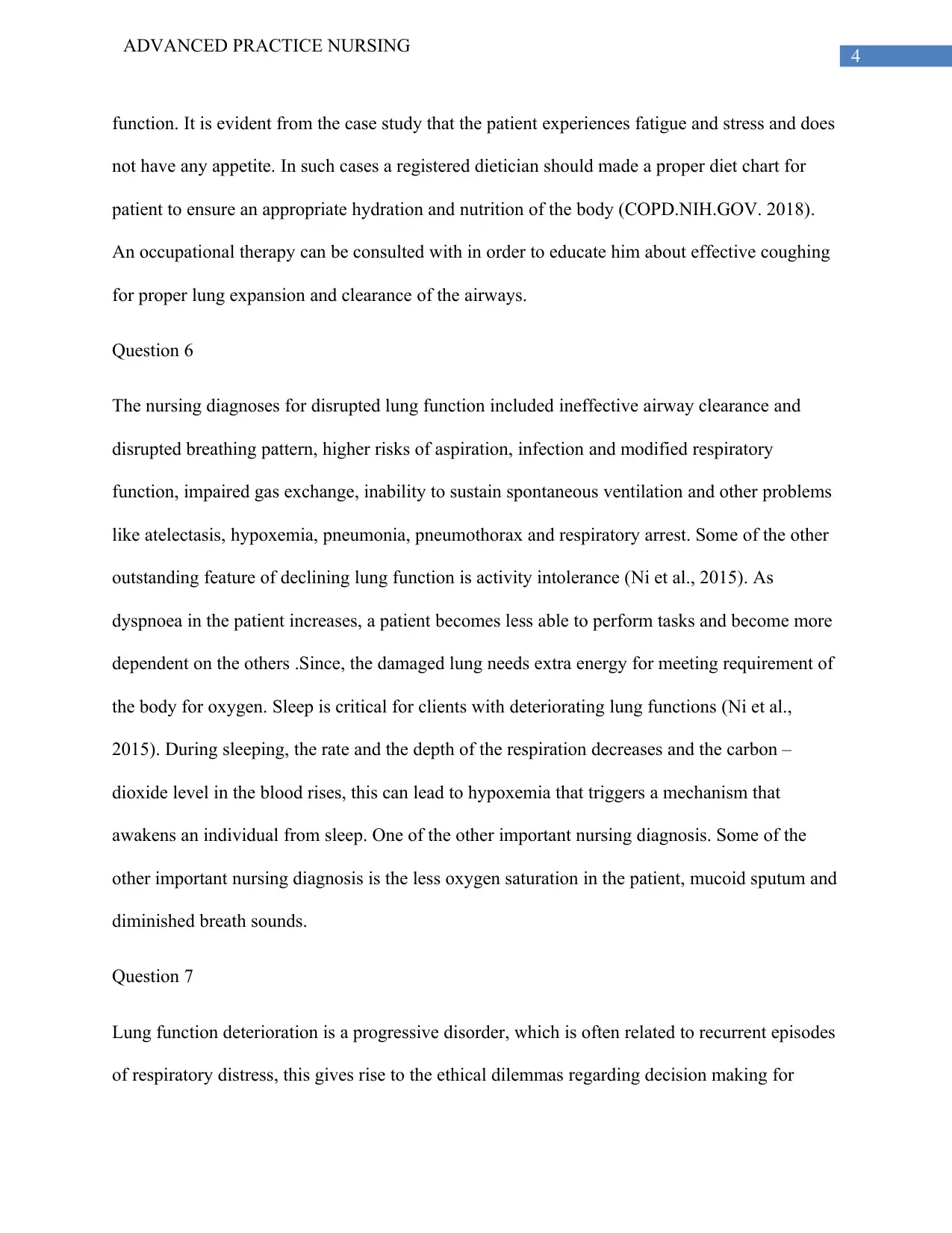
4
ADVANCED PRACTICE NURSING
function. It is evident from the case study that the patient experiences fatigue and stress and does
not have any appetite. In such cases a registered dietician should made a proper diet chart for
patient to ensure an appropriate hydration and nutrition of the body (COPD.NIH.GOV. 2018).
An occupational therapy can be consulted with in order to educate him about effective coughing
for proper lung expansion and clearance of the airways.
Question 6
The nursing diagnoses for disrupted lung function included ineffective airway clearance and
disrupted breathing pattern, higher risks of aspiration, infection and modified respiratory
function, impaired gas exchange, inability to sustain spontaneous ventilation and other problems
like atelectasis, hypoxemia, pneumonia, pneumothorax and respiratory arrest. Some of the other
outstanding feature of declining lung function is activity intolerance (Ni et al., 2015). As
dyspnoea in the patient increases, a patient becomes less able to perform tasks and become more
dependent on the others .Since, the damaged lung needs extra energy for meeting requirement of
the body for oxygen. Sleep is critical for clients with deteriorating lung functions (Ni et al.,
2015). During sleeping, the rate and the depth of the respiration decreases and the carbon –
dioxide level in the blood rises, this can lead to hypoxemia that triggers a mechanism that
awakens an individual from sleep. One of the other important nursing diagnosis. Some of the
other important nursing diagnosis is the less oxygen saturation in the patient, mucoid sputum and
diminished breath sounds.
Question 7
Lung function deterioration is a progressive disorder, which is often related to recurrent episodes
of respiratory distress, this gives rise to the ethical dilemmas regarding decision making for
ADVANCED PRACTICE NURSING
function. It is evident from the case study that the patient experiences fatigue and stress and does
not have any appetite. In such cases a registered dietician should made a proper diet chart for
patient to ensure an appropriate hydration and nutrition of the body (COPD.NIH.GOV. 2018).
An occupational therapy can be consulted with in order to educate him about effective coughing
for proper lung expansion and clearance of the airways.
Question 6
The nursing diagnoses for disrupted lung function included ineffective airway clearance and
disrupted breathing pattern, higher risks of aspiration, infection and modified respiratory
function, impaired gas exchange, inability to sustain spontaneous ventilation and other problems
like atelectasis, hypoxemia, pneumonia, pneumothorax and respiratory arrest. Some of the other
outstanding feature of declining lung function is activity intolerance (Ni et al., 2015). As
dyspnoea in the patient increases, a patient becomes less able to perform tasks and become more
dependent on the others .Since, the damaged lung needs extra energy for meeting requirement of
the body for oxygen. Sleep is critical for clients with deteriorating lung functions (Ni et al.,
2015). During sleeping, the rate and the depth of the respiration decreases and the carbon –
dioxide level in the blood rises, this can lead to hypoxemia that triggers a mechanism that
awakens an individual from sleep. One of the other important nursing diagnosis. Some of the
other important nursing diagnosis is the less oxygen saturation in the patient, mucoid sputum and
diminished breath sounds.
Question 7
Lung function deterioration is a progressive disorder, which is often related to recurrent episodes
of respiratory distress, this gives rise to the ethical dilemmas regarding decision making for
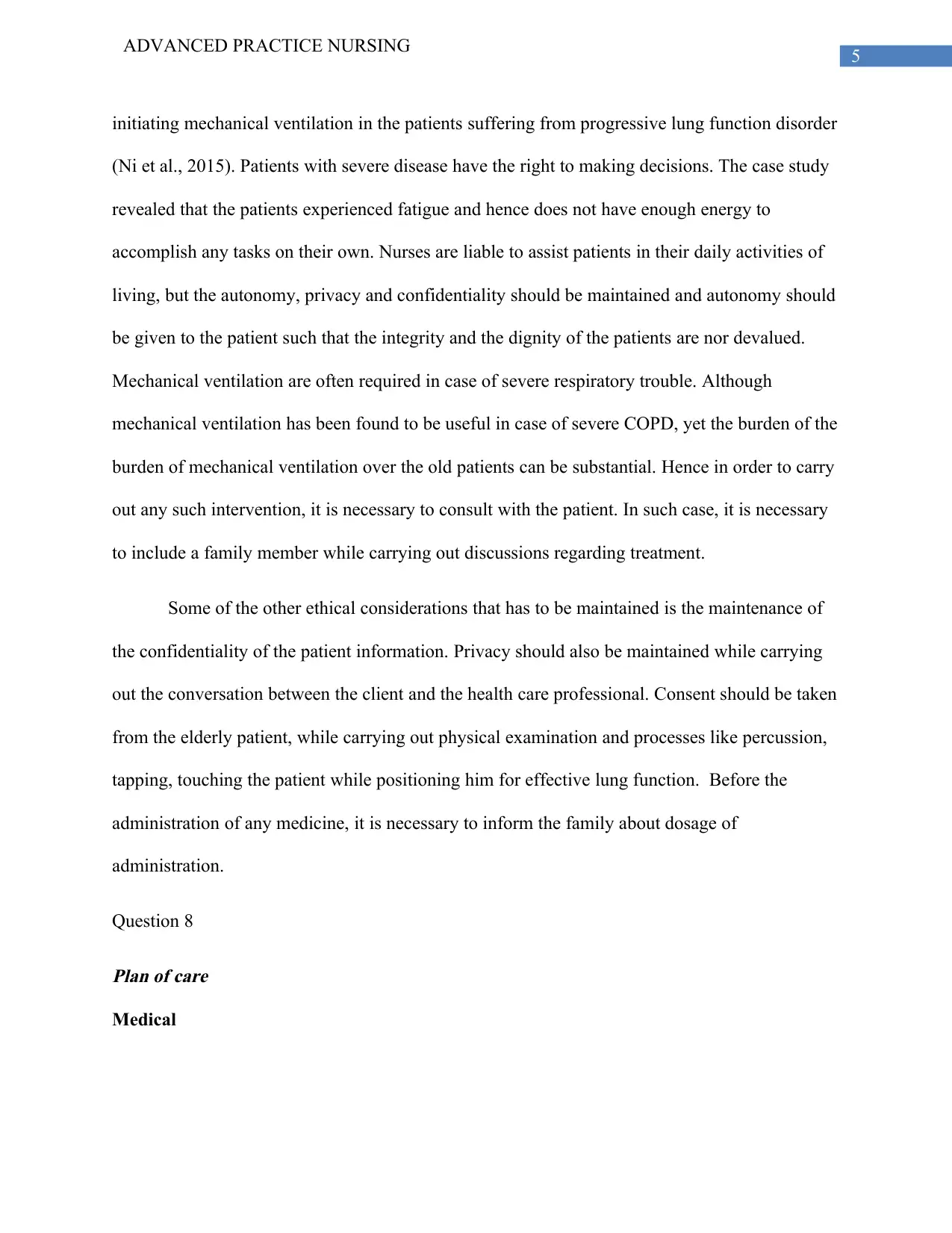
5
ADVANCED PRACTICE NURSING
initiating mechanical ventilation in the patients suffering from progressive lung function disorder
(Ni et al., 2015). Patients with severe disease have the right to making decisions. The case study
revealed that the patients experienced fatigue and hence does not have enough energy to
accomplish any tasks on their own. Nurses are liable to assist patients in their daily activities of
living, but the autonomy, privacy and confidentiality should be maintained and autonomy should
be given to the patient such that the integrity and the dignity of the patients are nor devalued.
Mechanical ventilation are often required in case of severe respiratory trouble. Although
mechanical ventilation has been found to be useful in case of severe COPD, yet the burden of the
burden of mechanical ventilation over the old patients can be substantial. Hence in order to carry
out any such intervention, it is necessary to consult with the patient. In such case, it is necessary
to include a family member while carrying out discussions regarding treatment.
Some of the other ethical considerations that has to be maintained is the maintenance of
the confidentiality of the patient information. Privacy should also be maintained while carrying
out the conversation between the client and the health care professional. Consent should be taken
from the elderly patient, while carrying out physical examination and processes like percussion,
tapping, touching the patient while positioning him for effective lung function. Before the
administration of any medicine, it is necessary to inform the family about dosage of
administration.
Question 8
Plan of care
Medical
ADVANCED PRACTICE NURSING
initiating mechanical ventilation in the patients suffering from progressive lung function disorder
(Ni et al., 2015). Patients with severe disease have the right to making decisions. The case study
revealed that the patients experienced fatigue and hence does not have enough energy to
accomplish any tasks on their own. Nurses are liable to assist patients in their daily activities of
living, but the autonomy, privacy and confidentiality should be maintained and autonomy should
be given to the patient such that the integrity and the dignity of the patients are nor devalued.
Mechanical ventilation are often required in case of severe respiratory trouble. Although
mechanical ventilation has been found to be useful in case of severe COPD, yet the burden of the
burden of mechanical ventilation over the old patients can be substantial. Hence in order to carry
out any such intervention, it is necessary to consult with the patient. In such case, it is necessary
to include a family member while carrying out discussions regarding treatment.
Some of the other ethical considerations that has to be maintained is the maintenance of
the confidentiality of the patient information. Privacy should also be maintained while carrying
out the conversation between the client and the health care professional. Consent should be taken
from the elderly patient, while carrying out physical examination and processes like percussion,
tapping, touching the patient while positioning him for effective lung function. Before the
administration of any medicine, it is necessary to inform the family about dosage of
administration.
Question 8
Plan of care
Medical
⊘ This is a preview!⊘
Do you want full access?
Subscribe today to unlock all pages.

Trusted by 1+ million students worldwide
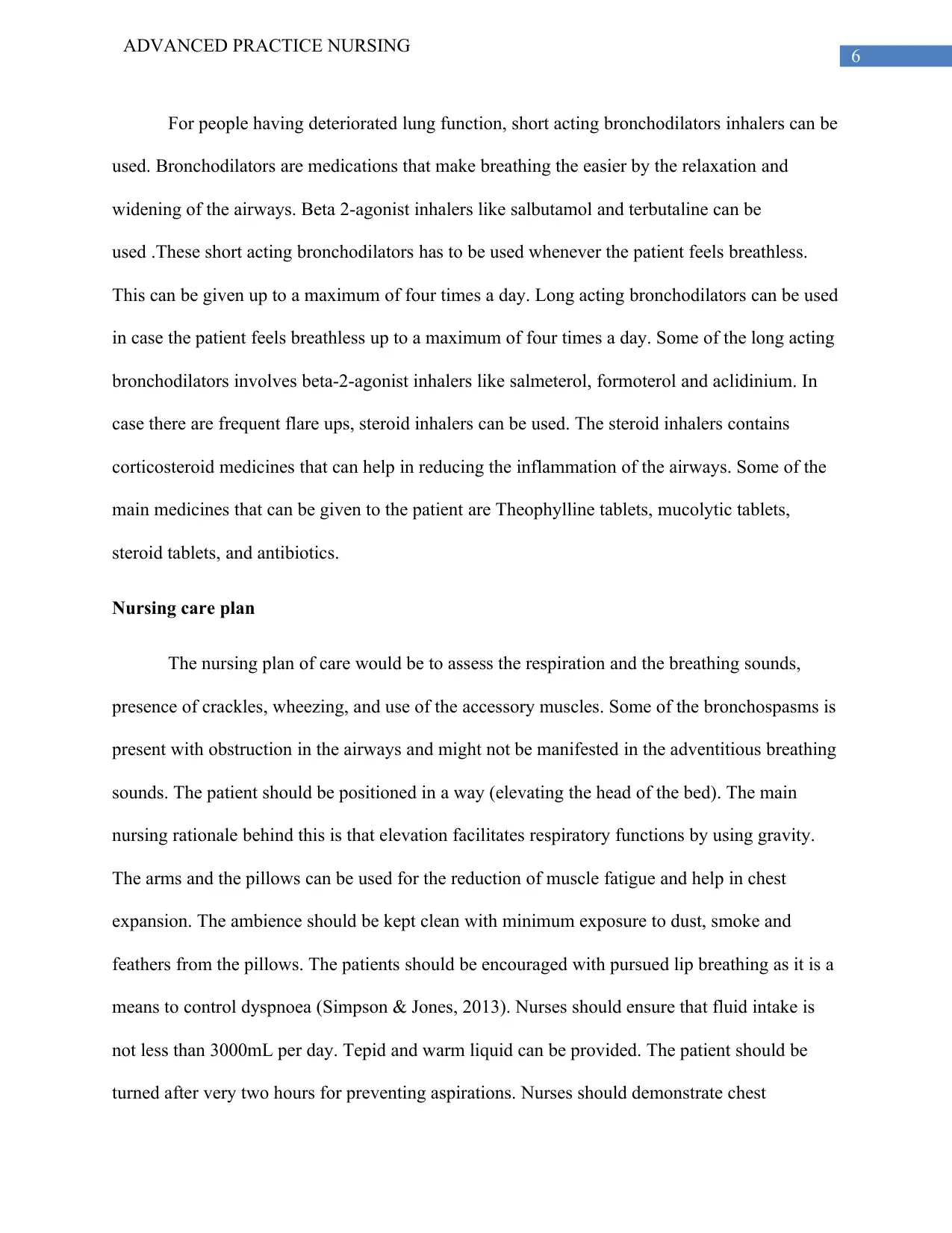
6
ADVANCED PRACTICE NURSING
For people having deteriorated lung function, short acting bronchodilators inhalers can be
used. Bronchodilators are medications that make breathing the easier by the relaxation and
widening of the airways. Beta 2-agonist inhalers like salbutamol and terbutaline can be
used .These short acting bronchodilators has to be used whenever the patient feels breathless.
This can be given up to a maximum of four times a day. Long acting bronchodilators can be used
in case the patient feels breathless up to a maximum of four times a day. Some of the long acting
bronchodilators involves beta-2-agonist inhalers like salmeterol, formoterol and aclidinium. In
case there are frequent flare ups, steroid inhalers can be used. The steroid inhalers contains
corticosteroid medicines that can help in reducing the inflammation of the airways. Some of the
main medicines that can be given to the patient are Theophylline tablets, mucolytic tablets,
steroid tablets, and antibiotics.
Nursing care plan
The nursing plan of care would be to assess the respiration and the breathing sounds,
presence of crackles, wheezing, and use of the accessory muscles. Some of the bronchospasms is
present with obstruction in the airways and might not be manifested in the adventitious breathing
sounds. The patient should be positioned in a way (elevating the head of the bed). The main
nursing rationale behind this is that elevation facilitates respiratory functions by using gravity.
The arms and the pillows can be used for the reduction of muscle fatigue and help in chest
expansion. The ambience should be kept clean with minimum exposure to dust, smoke and
feathers from the pillows. The patients should be encouraged with pursued lip breathing as it is a
means to control dyspnoea (Simpson & Jones, 2013). Nurses should ensure that fluid intake is
not less than 3000mL per day. Tepid and warm liquid can be provided. The patient should be
turned after very two hours for preventing aspirations. Nurses should demonstrate chest
ADVANCED PRACTICE NURSING
For people having deteriorated lung function, short acting bronchodilators inhalers can be
used. Bronchodilators are medications that make breathing the easier by the relaxation and
widening of the airways. Beta 2-agonist inhalers like salbutamol and terbutaline can be
used .These short acting bronchodilators has to be used whenever the patient feels breathless.
This can be given up to a maximum of four times a day. Long acting bronchodilators can be used
in case the patient feels breathless up to a maximum of four times a day. Some of the long acting
bronchodilators involves beta-2-agonist inhalers like salmeterol, formoterol and aclidinium. In
case there are frequent flare ups, steroid inhalers can be used. The steroid inhalers contains
corticosteroid medicines that can help in reducing the inflammation of the airways. Some of the
main medicines that can be given to the patient are Theophylline tablets, mucolytic tablets,
steroid tablets, and antibiotics.
Nursing care plan
The nursing plan of care would be to assess the respiration and the breathing sounds,
presence of crackles, wheezing, and use of the accessory muscles. Some of the bronchospasms is
present with obstruction in the airways and might not be manifested in the adventitious breathing
sounds. The patient should be positioned in a way (elevating the head of the bed). The main
nursing rationale behind this is that elevation facilitates respiratory functions by using gravity.
The arms and the pillows can be used for the reduction of muscle fatigue and help in chest
expansion. The ambience should be kept clean with minimum exposure to dust, smoke and
feathers from the pillows. The patients should be encouraged with pursued lip breathing as it is a
means to control dyspnoea (Simpson & Jones, 2013). Nurses should ensure that fluid intake is
not less than 3000mL per day. Tepid and warm liquid can be provided. The patient should be
turned after very two hours for preventing aspirations. Nurses should demonstrate chest
Paraphrase This Document
Need a fresh take? Get an instant paraphrase of this document with our AI Paraphraser
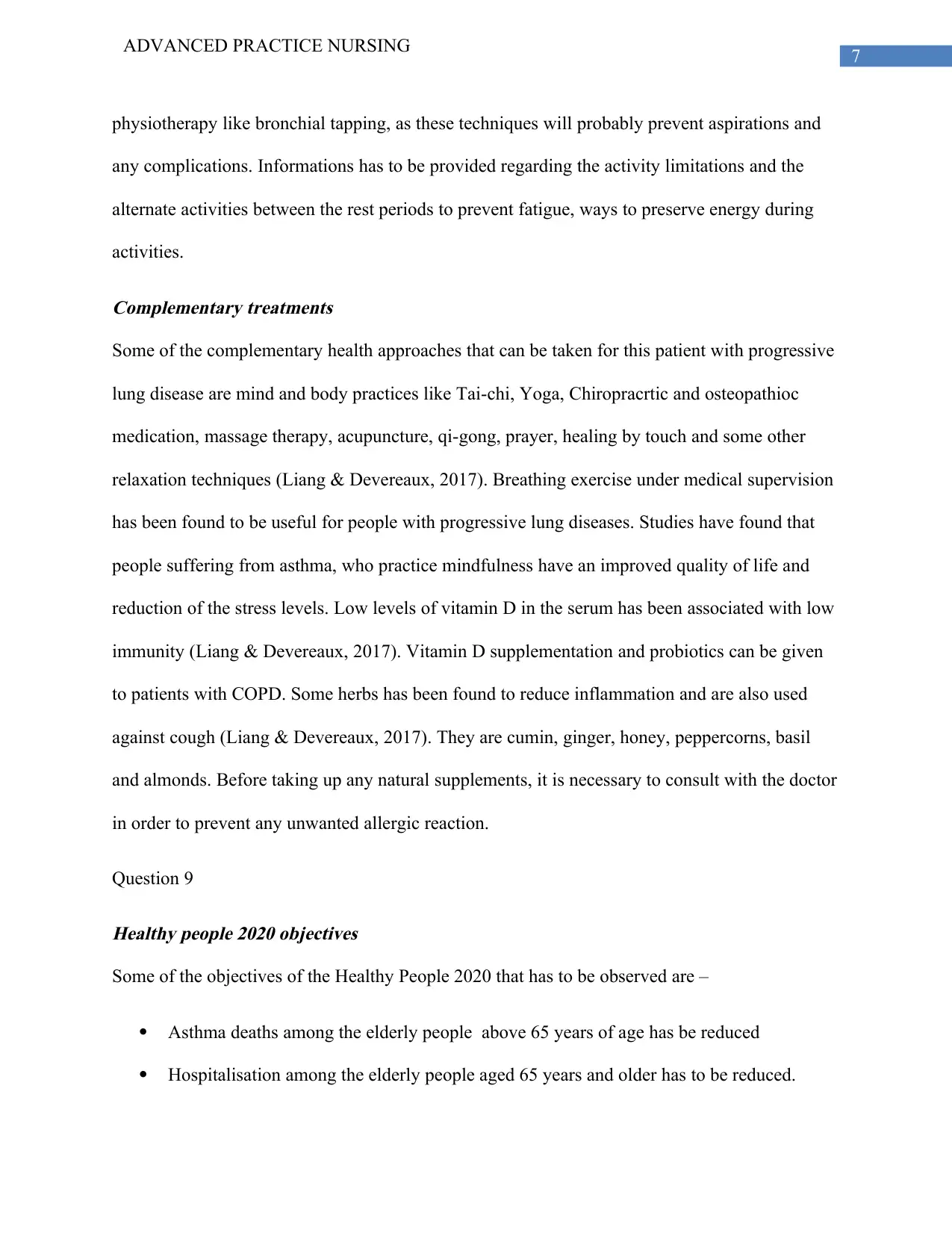
7
ADVANCED PRACTICE NURSING
physiotherapy like bronchial tapping, as these techniques will probably prevent aspirations and
any complications. Informations has to be provided regarding the activity limitations and the
alternate activities between the rest periods to prevent fatigue, ways to preserve energy during
activities.
Complementary treatments
Some of the complementary health approaches that can be taken for this patient with progressive
lung disease are mind and body practices like Tai-chi, Yoga, Chiropracrtic and osteopathioc
medication, massage therapy, acupuncture, qi-gong, prayer, healing by touch and some other
relaxation techniques (Liang & Devereaux, 2017). Breathing exercise under medical supervision
has been found to be useful for people with progressive lung diseases. Studies have found that
people suffering from asthma, who practice mindfulness have an improved quality of life and
reduction of the stress levels. Low levels of vitamin D in the serum has been associated with low
immunity (Liang & Devereaux, 2017). Vitamin D supplementation and probiotics can be given
to patients with COPD. Some herbs has been found to reduce inflammation and are also used
against cough (Liang & Devereaux, 2017). They are cumin, ginger, honey, peppercorns, basil
and almonds. Before taking up any natural supplements, it is necessary to consult with the doctor
in order to prevent any unwanted allergic reaction.
Question 9
Healthy people 2020 objectives
Some of the objectives of the Healthy People 2020 that has to be observed are –
Asthma deaths among the elderly people above 65 years of age has be reduced
Hospitalisation among the elderly people aged 65 years and older has to be reduced.
ADVANCED PRACTICE NURSING
physiotherapy like bronchial tapping, as these techniques will probably prevent aspirations and
any complications. Informations has to be provided regarding the activity limitations and the
alternate activities between the rest periods to prevent fatigue, ways to preserve energy during
activities.
Complementary treatments
Some of the complementary health approaches that can be taken for this patient with progressive
lung disease are mind and body practices like Tai-chi, Yoga, Chiropracrtic and osteopathioc
medication, massage therapy, acupuncture, qi-gong, prayer, healing by touch and some other
relaxation techniques (Liang & Devereaux, 2017). Breathing exercise under medical supervision
has been found to be useful for people with progressive lung diseases. Studies have found that
people suffering from asthma, who practice mindfulness have an improved quality of life and
reduction of the stress levels. Low levels of vitamin D in the serum has been associated with low
immunity (Liang & Devereaux, 2017). Vitamin D supplementation and probiotics can be given
to patients with COPD. Some herbs has been found to reduce inflammation and are also used
against cough (Liang & Devereaux, 2017). They are cumin, ginger, honey, peppercorns, basil
and almonds. Before taking up any natural supplements, it is necessary to consult with the doctor
in order to prevent any unwanted allergic reaction.
Question 9
Healthy people 2020 objectives
Some of the objectives of the Healthy People 2020 that has to be observed are –
Asthma deaths among the elderly people above 65 years of age has be reduced
Hospitalisation among the elderly people aged 65 years and older has to be reduced.
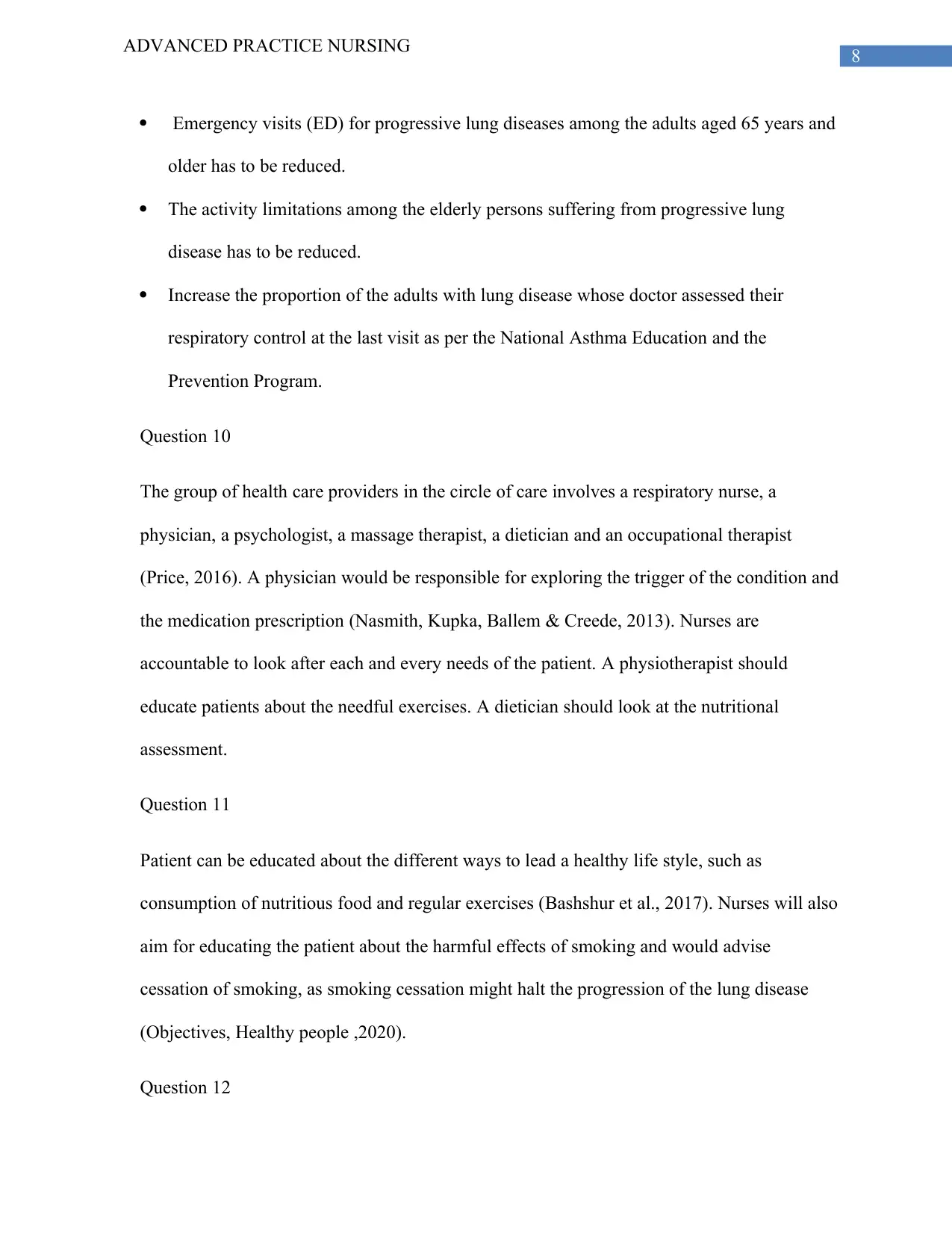
8
ADVANCED PRACTICE NURSING
Emergency visits (ED) for progressive lung diseases among the adults aged 65 years and
older has to be reduced.
The activity limitations among the elderly persons suffering from progressive lung
disease has to be reduced.
Increase the proportion of the adults with lung disease whose doctor assessed their
respiratory control at the last visit as per the National Asthma Education and the
Prevention Program.
Question 10
The group of health care providers in the circle of care involves a respiratory nurse, a
physician, a psychologist, a massage therapist, a dietician and an occupational therapist
(Price, 2016). A physician would be responsible for exploring the trigger of the condition and
the medication prescription (Nasmith, Kupka, Ballem & Creede, 2013). Nurses are
accountable to look after each and every needs of the patient. A physiotherapist should
educate patients about the needful exercises. A dietician should look at the nutritional
assessment.
Question 11
Patient can be educated about the different ways to lead a healthy life style, such as
consumption of nutritious food and regular exercises (Bashshur et al., 2017). Nurses will also
aim for educating the patient about the harmful effects of smoking and would advise
cessation of smoking, as smoking cessation might halt the progression of the lung disease
(Objectives, Healthy people ,2020).
Question 12
ADVANCED PRACTICE NURSING
Emergency visits (ED) for progressive lung diseases among the adults aged 65 years and
older has to be reduced.
The activity limitations among the elderly persons suffering from progressive lung
disease has to be reduced.
Increase the proportion of the adults with lung disease whose doctor assessed their
respiratory control at the last visit as per the National Asthma Education and the
Prevention Program.
Question 10
The group of health care providers in the circle of care involves a respiratory nurse, a
physician, a psychologist, a massage therapist, a dietician and an occupational therapist
(Price, 2016). A physician would be responsible for exploring the trigger of the condition and
the medication prescription (Nasmith, Kupka, Ballem & Creede, 2013). Nurses are
accountable to look after each and every needs of the patient. A physiotherapist should
educate patients about the needful exercises. A dietician should look at the nutritional
assessment.
Question 11
Patient can be educated about the different ways to lead a healthy life style, such as
consumption of nutritious food and regular exercises (Bashshur et al., 2017). Nurses will also
aim for educating the patient about the harmful effects of smoking and would advise
cessation of smoking, as smoking cessation might halt the progression of the lung disease
(Objectives, Healthy people ,2020).
Question 12
⊘ This is a preview!⊘
Do you want full access?
Subscribe today to unlock all pages.

Trusted by 1+ million students worldwide
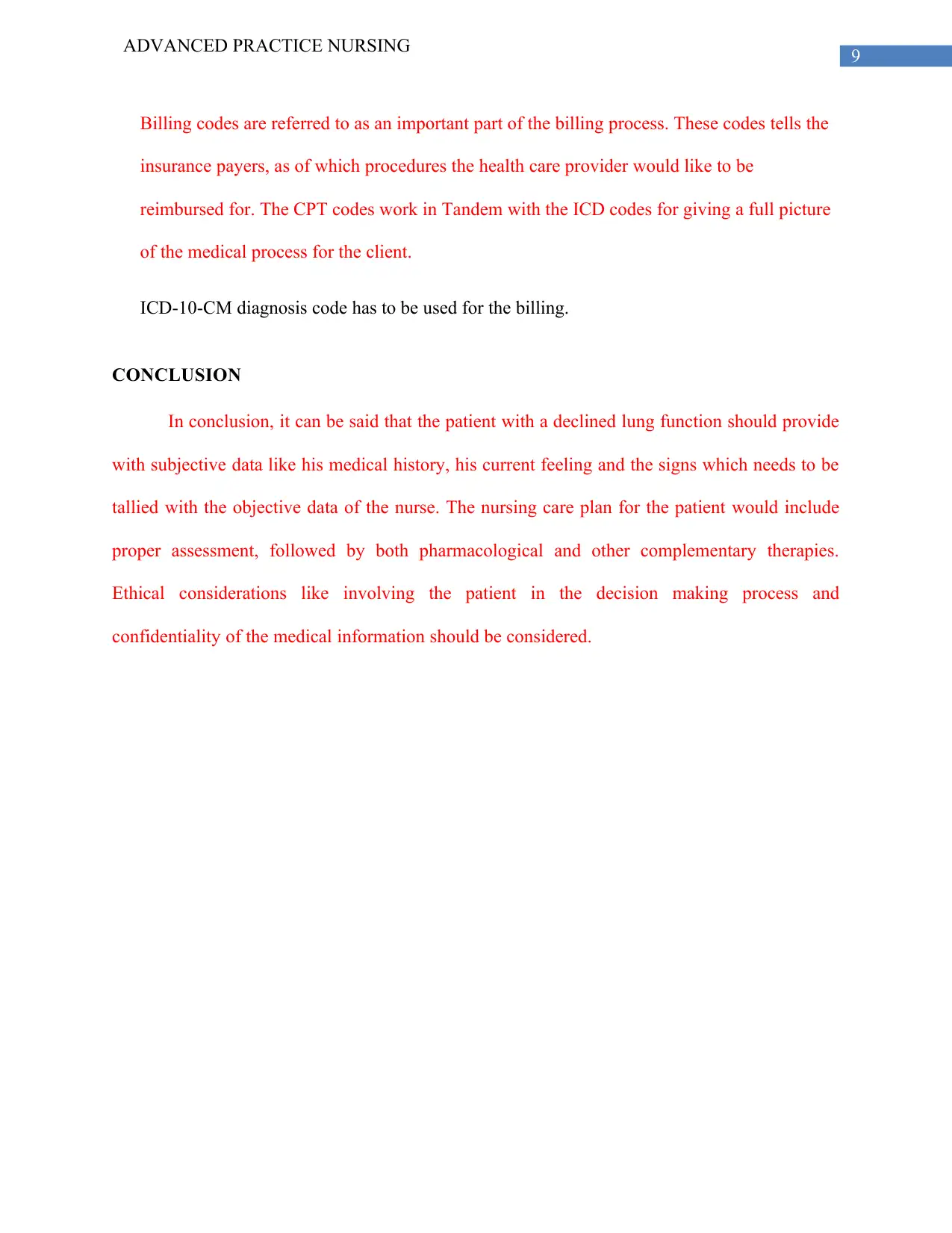
9
ADVANCED PRACTICE NURSING
Billing codes are referred to as an important part of the billing process. These codes tells the
insurance payers, as of which procedures the health care provider would like to be
reimbursed for. The CPT codes work in Tandem with the ICD codes for giving a full picture
of the medical process for the client.
ICD-10-CM diagnosis code has to be used for the billing.
CONCLUSION
In conclusion, it can be said that the patient with a declined lung function should provide
with subjective data like his medical history, his current feeling and the signs which needs to be
tallied with the objective data of the nurse. The nursing care plan for the patient would include
proper assessment, followed by both pharmacological and other complementary therapies.
Ethical considerations like involving the patient in the decision making process and
confidentiality of the medical information should be considered.
ADVANCED PRACTICE NURSING
Billing codes are referred to as an important part of the billing process. These codes tells the
insurance payers, as of which procedures the health care provider would like to be
reimbursed for. The CPT codes work in Tandem with the ICD codes for giving a full picture
of the medical process for the client.
ICD-10-CM diagnosis code has to be used for the billing.
CONCLUSION
In conclusion, it can be said that the patient with a declined lung function should provide
with subjective data like his medical history, his current feeling and the signs which needs to be
tallied with the objective data of the nurse. The nursing care plan for the patient would include
proper assessment, followed by both pharmacological and other complementary therapies.
Ethical considerations like involving the patient in the decision making process and
confidentiality of the medical information should be considered.
Paraphrase This Document
Need a fresh take? Get an instant paraphrase of this document with our AI Paraphraser
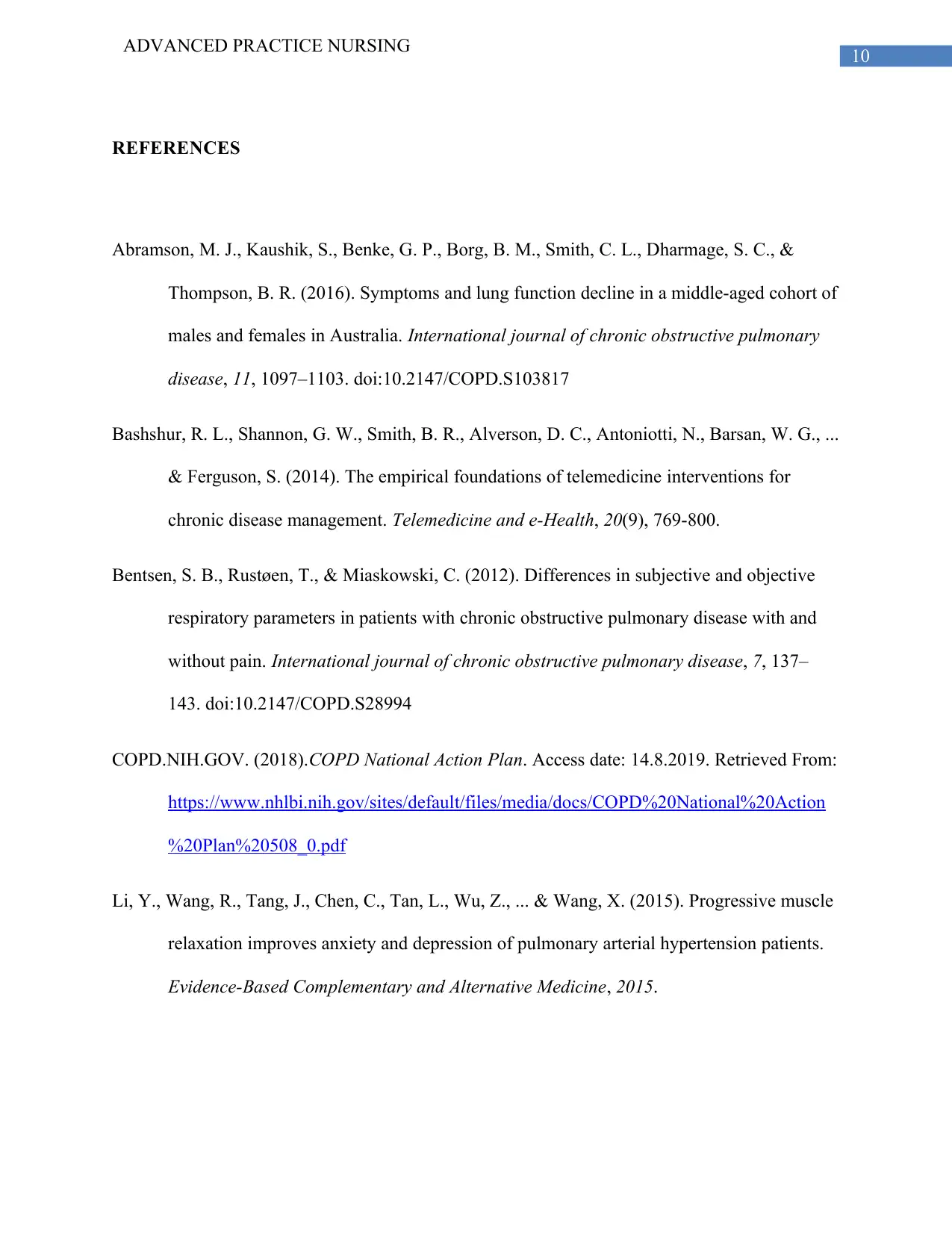
10
ADVANCED PRACTICE NURSING
REFERENCES
Abramson, M. J., Kaushik, S., Benke, G. P., Borg, B. M., Smith, C. L., Dharmage, S. C., &
Thompson, B. R. (2016). Symptoms and lung function decline in a middle-aged cohort of
males and females in Australia. International journal of chronic obstructive pulmonary
disease, 11, 1097–1103. doi:10.2147/COPD.S103817
Bashshur, R. L., Shannon, G. W., Smith, B. R., Alverson, D. C., Antoniotti, N., Barsan, W. G., ...
& Ferguson, S. (2014). The empirical foundations of telemedicine interventions for
chronic disease management. Telemedicine and e-Health, 20(9), 769-800.
Bentsen, S. B., Rustøen, T., & Miaskowski, C. (2012). Differences in subjective and objective
respiratory parameters in patients with chronic obstructive pulmonary disease with and
without pain. International journal of chronic obstructive pulmonary disease, 7, 137–
143. doi:10.2147/COPD.S28994
COPD.NIH.GOV. (2018).COPD National Action Plan. Access date: 14.8.2019. Retrieved From:
https://www.nhlbi.nih.gov/sites/default/files/media/docs/COPD%20National%20Action
%20Plan%20508_0.pdf
Li, Y., Wang, R., Tang, J., Chen, C., Tan, L., Wu, Z., ... & Wang, X. (2015). Progressive muscle
relaxation improves anxiety and depression of pulmonary arterial hypertension patients.
Evidence-Based Complementary and Alternative Medicine, 2015.
ADVANCED PRACTICE NURSING
REFERENCES
Abramson, M. J., Kaushik, S., Benke, G. P., Borg, B. M., Smith, C. L., Dharmage, S. C., &
Thompson, B. R. (2016). Symptoms and lung function decline in a middle-aged cohort of
males and females in Australia. International journal of chronic obstructive pulmonary
disease, 11, 1097–1103. doi:10.2147/COPD.S103817
Bashshur, R. L., Shannon, G. W., Smith, B. R., Alverson, D. C., Antoniotti, N., Barsan, W. G., ...
& Ferguson, S. (2014). The empirical foundations of telemedicine interventions for
chronic disease management. Telemedicine and e-Health, 20(9), 769-800.
Bentsen, S. B., Rustøen, T., & Miaskowski, C. (2012). Differences in subjective and objective
respiratory parameters in patients with chronic obstructive pulmonary disease with and
without pain. International journal of chronic obstructive pulmonary disease, 7, 137–
143. doi:10.2147/COPD.S28994
COPD.NIH.GOV. (2018).COPD National Action Plan. Access date: 14.8.2019. Retrieved From:
https://www.nhlbi.nih.gov/sites/default/files/media/docs/COPD%20National%20Action
%20Plan%20508_0.pdf
Li, Y., Wang, R., Tang, J., Chen, C., Tan, L., Wu, Z., ... & Wang, X. (2015). Progressive muscle
relaxation improves anxiety and depression of pulmonary arterial hypertension patients.
Evidence-Based Complementary and Alternative Medicine, 2015.
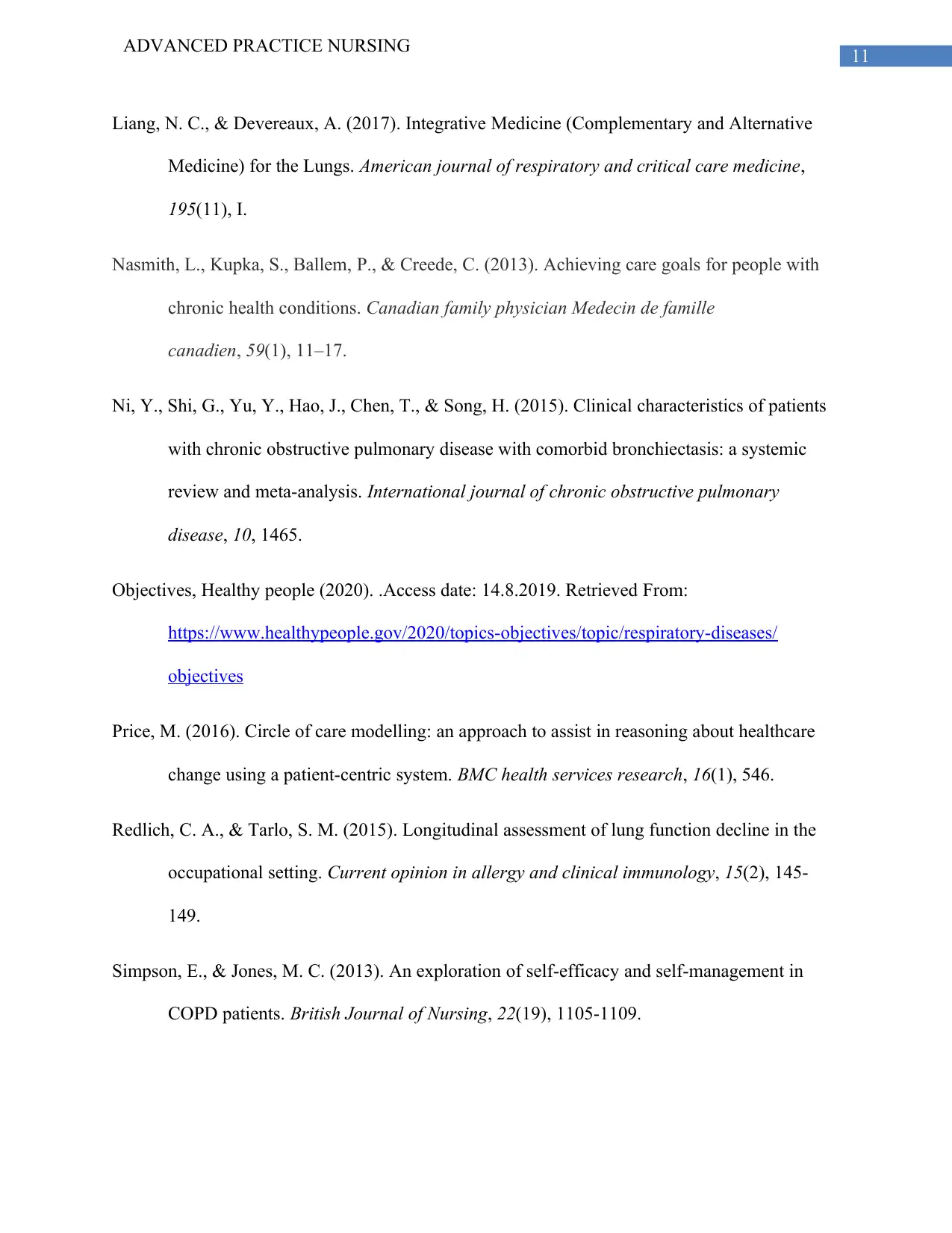
11
ADVANCED PRACTICE NURSING
Liang, N. C., & Devereaux, A. (2017). Integrative Medicine (Complementary and Alternative
Medicine) for the Lungs. American journal of respiratory and critical care medicine,
195(11), I.
Nasmith, L., Kupka, S., Ballem, P., & Creede, C. (2013). Achieving care goals for people with
chronic health conditions. Canadian family physician Medecin de famille
canadien, 59(1), 11–17.
Ni, Y., Shi, G., Yu, Y., Hao, J., Chen, T., & Song, H. (2015). Clinical characteristics of patients
with chronic obstructive pulmonary disease with comorbid bronchiectasis: a systemic
review and meta-analysis. International journal of chronic obstructive pulmonary
disease, 10, 1465.
Objectives, Healthy people (2020). .Access date: 14.8.2019. Retrieved From:
https://www.healthypeople.gov/2020/topics-objectives/topic/respiratory-diseases/
objectives
Price, M. (2016). Circle of care modelling: an approach to assist in reasoning about healthcare
change using a patient-centric system. BMC health services research, 16(1), 546.
Redlich, C. A., & Tarlo, S. M. (2015). Longitudinal assessment of lung function decline in the
occupational setting. Current opinion in allergy and clinical immunology, 15(2), 145-
149.
Simpson, E., & Jones, M. C. (2013). An exploration of self-efficacy and self-management in
COPD patients. British Journal of Nursing, 22(19), 1105-1109.
ADVANCED PRACTICE NURSING
Liang, N. C., & Devereaux, A. (2017). Integrative Medicine (Complementary and Alternative
Medicine) for the Lungs. American journal of respiratory and critical care medicine,
195(11), I.
Nasmith, L., Kupka, S., Ballem, P., & Creede, C. (2013). Achieving care goals for people with
chronic health conditions. Canadian family physician Medecin de famille
canadien, 59(1), 11–17.
Ni, Y., Shi, G., Yu, Y., Hao, J., Chen, T., & Song, H. (2015). Clinical characteristics of patients
with chronic obstructive pulmonary disease with comorbid bronchiectasis: a systemic
review and meta-analysis. International journal of chronic obstructive pulmonary
disease, 10, 1465.
Objectives, Healthy people (2020). .Access date: 14.8.2019. Retrieved From:
https://www.healthypeople.gov/2020/topics-objectives/topic/respiratory-diseases/
objectives
Price, M. (2016). Circle of care modelling: an approach to assist in reasoning about healthcare
change using a patient-centric system. BMC health services research, 16(1), 546.
Redlich, C. A., & Tarlo, S. M. (2015). Longitudinal assessment of lung function decline in the
occupational setting. Current opinion in allergy and clinical immunology, 15(2), 145-
149.
Simpson, E., & Jones, M. C. (2013). An exploration of self-efficacy and self-management in
COPD patients. British Journal of Nursing, 22(19), 1105-1109.
⊘ This is a preview!⊘
Do you want full access?
Subscribe today to unlock all pages.

Trusted by 1+ million students worldwide
1 out of 13
Related Documents
Your All-in-One AI-Powered Toolkit for Academic Success.
+13062052269
info@desklib.com
Available 24*7 on WhatsApp / Email
![[object Object]](/_next/static/media/star-bottom.7253800d.svg)
Unlock your academic potential
Copyright © 2020–2025 A2Z Services. All Rights Reserved. Developed and managed by ZUCOL.





